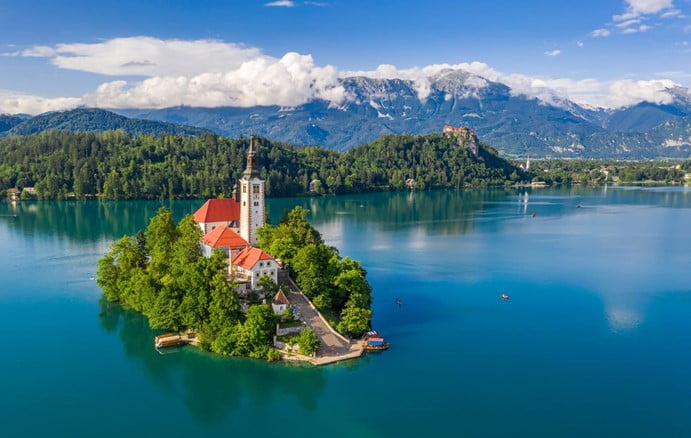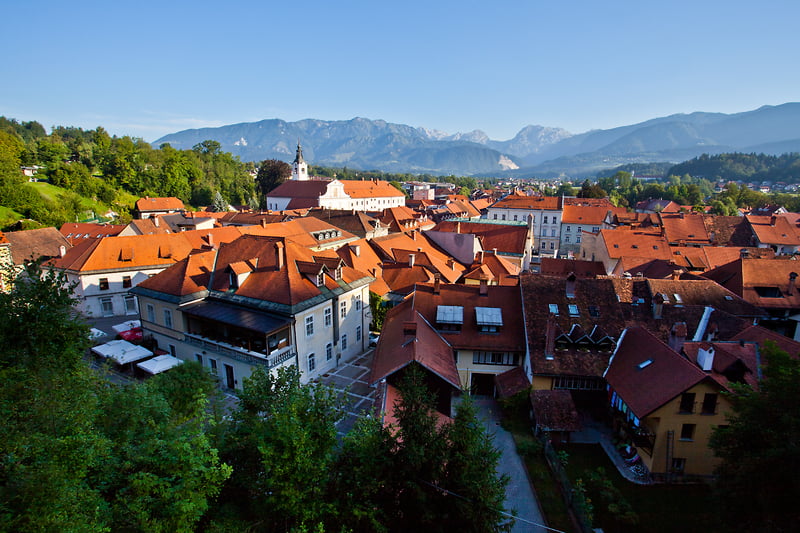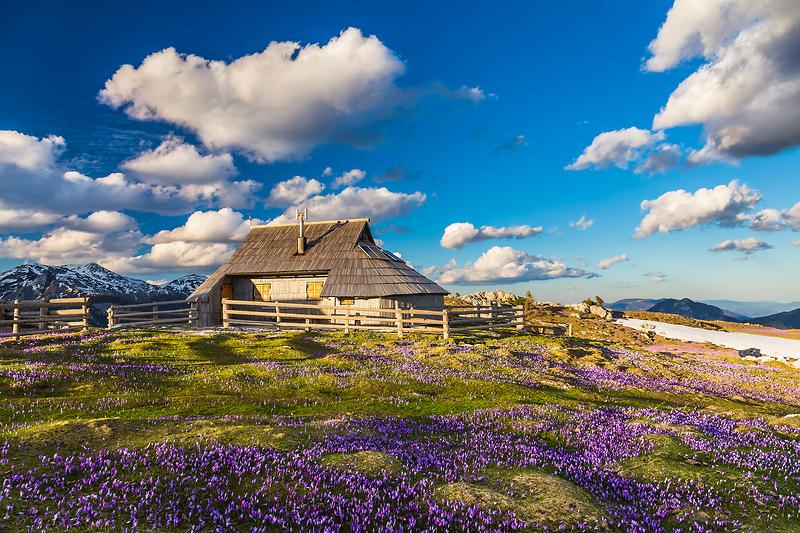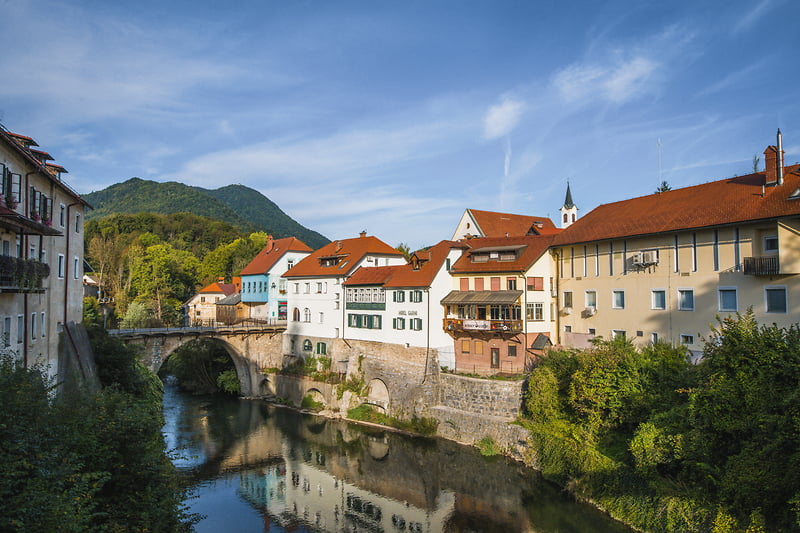Slovenia may be small, but boy oh boy is it perfectly formed. Lovely Ljubljana is the perfect base from which to explore the country, with a wide range of history, culture, entertainment, and activity within a two-hour drive of the capital. Two hours is good an all, but the modern world is a fast-moving place; where can we visit just one hour away from Ljubljana?
These are some of our favorite places just an hour from LJ.
1. Lake Bled
Where else to start? Slovenia’s most magical natural setting is a 40-minute drive north of the capital, a gorgeous ride through quaint villages and tranquil Slovenian countryside. Lake Bled is about as picture-perfect as it gets, a quite gorgeous lake surrounded by jagged mountains and a famous castle. Lake Bled is one of the most popular day trips from Ljubljana, although you might find yourself staying forever and ever.
Lake Bled, nestled in the Julian Alps of Slovenia, is famous for its stunning beauty and tranquil atmosphere. The lake boasts emerald-green water (when sunny) and features a small island with the iconic Assumption of Mary Church. Visitors can enjoy the peaceful surroundings by renting a traditional wooden pletna boat or hiking up to Bled Castle for panoramic views.
The town of Bled itself offers a mix of cozy cafes, unique shops, and scenic lakeside promenades, ideal for relaxed walks. Adventurous visitors can explore the nearby hills on foot or bike along designated trails, immersing themselves in the pristine natural environment. Beyond its natural charm, Lake Bled also hosts cultural events that highlight Slovenia’s traditions.
Whether you’re visiting for a day trip from Ljubljana or planning a longer stay, Lake Bled promises an unforgettable experience, characterized by its picturesque landscapes and rich cultural heritage.
Click HERE for more about Bled.

2. Kranj
Kranj, often referred to as the “capital of the Slovenian Alps,” is a charming city located in the northwest of Slovenia, approximately 25 kilometers northwest of Ljubljana. It serves as the administrative, economic, cultural, and educational hub of the Upper Carniola region.
It is the fourth-largest town in Slovenia.
The city is known for its rich history dating back to prehistoric times, evident from archaeological findings in the area. Kranj’s medieval old town is a delightful mix of narrow cobblestone streets, colorful houses, and historic churches, including the impressive St. Cantianus and Companions Parish Church.
Modern-day Kranj is bustling with cultural activities, boasting several museums, galleries, and theaters. The Khislstein Castle, perched on a hill overlooking the city, offers visitors panoramic views and a glimpse into the region’s past through its museum.
Kranj is also a center for music and arts in Slovenia, hosting numerous festivals and events throughout the year. Its vibrant atmosphere, coupled with its proximity to natural attractions like the Sava River and nearby mountains, makes Kranj a perfect blend of history, culture, and outdoor adventure.
Click HERE to find out more about Kranj.
3. Postojna & Postojna Cave
Sticking with the most popular attractions in Slovenia, Postojna Cave and Predjama Castle often find themselves bossing the business end of Slovenian tourism.
Postojna is a small town located in southwestern Slovenia, known internationally primarily for its remarkable karst landscapes and the famous Postojna Cave. The town is situated approximately 50 kilometers southwest of Ljubljana and is easily accessible by road or train.
The Postojna Cave is one of Slovenia’s most popular tourist attractions, drawing visitors from around the world to marvel at its underground wonders. This extensive cave system, over 24 kilometers long, features stunning stalactites, stalagmites, and other intricate limestone formations. Guided tours take visitors deep into the cave’s chambers, including a ride on an electric train that traverses through the largest sections.
Apart from the cave, Postojna offers a quaint town center with charming streets, cafes, and shops. Nearby attractions include the Predjama Castle, a medieval castle built into a cliff face and famous for its dramatic location and intriguing history.
Postojna also serves as a gateway to explore the wider Karst region, known for its unique geological features, picturesque villages, and excellent opportunities for outdoor activities such as hiking and cycling.
Overall, Postojna is a must-visit destination in Slovenia, offering both natural wonders and cultural experiences that cater to a wide range of interests.

3. Radovljica
Slovenia’s most underrated town? Radovljica might just take that tasty cake. A most adorable medieval town just 35-minutes north of Ljubljana, Radovljica is home to one of the country’s most picturesque settings and a couple of its most charming museums, namely the Beekeeping Museum and Pharmacy Museum. Sweet Radolca doesn’t get the attention of more celebrated contemporaries, but it could just be your new favourite town. Also, there is a Chocolate Festival. Need we say more?
Radovljica is a small town nestled in the foothills of the Julian Alps in northwestern Slovenia, situated just 7 kilometers northwest of Bled. Known for its well-preserved medieval architecture and picturesque setting along the Sava River, Radovljica offers visitors a charming glimpse into Slovenia’s history and culture.
The town’s historic old town, adorned with beautifully preserved frescoes and colorful facades, invites leisurely strolls through its narrow streets. The centerpiece is Linhart Square, named after the Slovenian playwright Anton Tomaž Linhart, featuring elegant buildings from the 16th century onwards. Here, visitors can explore the Radovljica Mansion, which houses a museum showcasing local history and culture.
Nature enthusiasts will appreciate Radovljica’s proximity to the surrounding mountains and forests, ideal for hiking, cycling, and other outdoor activities. The town’s peaceful ambiance and scenic landscapes make it a delightful stop for travelers seeking a blend of history, culture, and natural beauty in Slovenia.

4. Kamnik
Kamnik is a historic and magnificent town nestled in a picturesque valley at the foothills of the Kamnik-Savinja Alps in northern Slovenia, an easy 25 minute drive from Ljubljana. It often flies under the radar of tourists but that is just how it likes it. This is a living, breathing homage to all things creative. This charming town is known for its rich cultural heritage, stunning natural surroundings, and outdoor recreational opportunities.
The town’s history dates back to Roman times, and its medieval core features well-preserved architecture, including colorful facades, quaint squares, and the impressive Mali grad (Little Castle). The Stari grad (Old Castle) perched on a hill offers panoramic views of the town and surrounding mountains.
Kamnik is a popular destination for outdoor enthusiasts, offering numerous hiking trails that lead through lush forests, alpine meadows, and past pristine rivers. The nearby Kamniška Bistrica Valley is a gateway to the Kamnik-Savinja Alps, renowned for its rugged peaks, crystal-clear lakes, and diverse flora and fauna.
Cultural attractions in Kamnik include the Kamnik Intermunicipal Museum, housed in a former monastery, which showcases exhibitions on local history, ethnography, and archaeology. The town also hosts various festivals and events throughout the year, celebrating traditions, music, and arts.
With its blend of history, natural beauty, and recreational opportunities, Kamnik provides visitors with a unique glimpse into Slovenia’s diverse landscape and cultural heritage.
Click HERE to read more about Kamnik.
5. Velika Planina
Velika Planina, translated as “Big Pasture Plateau,” is a unique and picturesque alpine plateau located in the Kamnik-Savinja Alps of Slovenia, near the town of Kamnik. This expansive highland, situated at an elevation of around 1,500 meters above sea level, is renowned for its stunning natural beauty and traditional Alpine architecture.
The plateau is famous for its pastoral scenery dotted with hundreds of traditional wooden herdsmen’s huts, known as ‘kozolec’ in Slovenian, which serve as seasonal shelters for shepherds and their livestock. These huts, with their distinctive conical roofs, create a rustic and charming atmosphere that harkens back to centuries-old pastoral traditions.
Velika Planina is accessible via a cable car ride from the valley below, providing visitors with breathtaking panoramic views of the surrounding mountains and valleys during the ascent. Once on the plateau, visitors can explore the network of hiking trails that lead through lush meadows, dense forests, and past alpine streams. The area is particularly popular for hiking, nature walks, and photography, offering opportunities to observe local wildlife and enjoy the serene mountain environment.
In addition to its natural splendor, Velika Planina hosts cultural events and activities that celebrate traditional Alpine customs, such as cheese-making and folk music. Visitors can also sample local specialties, including freshly made dairy products and traditional Slovenian dishes at mountain huts and restaurants scattered across the plateau.
Velika Planina is a haven for those seeking tranquility, natural beauty, and a glimpse into Slovenia’s rich cultural heritage amidst stunning alpine landscapes.
Click HERE to find out more.
6. Trbovlje
Trbovlje is a Slovenian anomaly. Often derided as one of the country’s ugliest towns, this famous industrial centre will surprise you.
Trbovlje is a town located in central Slovenia, situated along the banks of the Sava River and nestled within the picturesque valley of the same name. Historically, Trbovlje has been known for its mining industry, particularly coal mining, which played a significant role in shaping the town’s development and identity.
The town’s industrial heritage is reflected in its architecture, with remnants of old mining facilities and industrial buildings dotting the landscape. Trbovlje’s iconic landmark is the towering chimney of the former Trbovlje Power Station, a symbol of the town’s industrial past and now a cultural heritage site.
In recent years, Trbovlje has undergone a transformation, embracing its industrial history while diversifying its economy and cultural offerings. The town boasts several museums and cultural institutions, including the Trbovlje Museum, which showcases the region’s mining heritage and cultural artifacts.
Trbovlje is also known for its vibrant arts scene, hosting events such as the Trbovlje New Media Festival (TENMF), which celebrates digital art and innovation. The town’s cultural center, Delavski dom Trbovlje, serves as a hub for artistic performances, exhibitions, and community events.
Surrounded by the scenic hills and forests of the Zasavje region, Trbovlje offers outdoor enthusiasts opportunities for hiking, cycling, and exploring nearby natural attractions such as the Kum Mountain and the picturesque Sava River.
In summary, Trbovlje is a town rich in industrial history, cultural heritage, and natural beauty, making it a fascinating destination for visitors interested in exploring Slovenia’s diverse landscapes and cultural tapestry.
7. Škofja Loka
Splendid Škofja Loka should be on all positive travel-centric lists, such are its immediate charms and aesthetic prowess.
Škofja Loka is a quaint medieval town nestled in the Selca Valley, between the Sora and Poljane rivers, in the northwest part of Slovenia. Located about 23 kilometers northwest of Ljubljana, it is one of the country’s oldest and most charming towns, renowned for its well-preserved medieval architecture and rich cultural heritage.
The town’s history dates back to the 12th century, and its picturesque old town is a testament to its medieval roots. Narrow cobblestone streets wind through the town center, lined with colorful houses adorned with frescoes and adorned facades. Škofja Loka boasts numerous historical landmarks, including the imposing Škofja Loka Castle, which overlooks the town and houses a museum that showcases the region’s history.
Visitors to Škofja Loka can explore its medieval squares, such as Mestni trg (Town Square) and Spodnji trg (Lower Square), where they can admire Gothic and Baroque architecture and visit local artisan shops and cafes. The Capuchin Bridge, with its picturesque views of the town and rivers below, is another popular spot for visitors.
Cultural events and festivals are an integral part of Škofja Loka’s charm, including the traditional Passion Play, performed every six years, and various music and art festivals throughout the year. The town’s rich cultural heritage is also celebrated in its museums, galleries, and exhibitions.
Surrounded by rolling hills, lush forests, and the majestic peaks of the Julian Alps, Škofja Loka offers ample opportunities for outdoor activities such as hiking, cycling, and exploring nearby nature reserves and scenic viewpoints.
In summary, Škofja Loka is a hidden gem in Slovenia, offering visitors a blend of history, culture, and natural beauty in a beautifully preserved medieval setting.
Click HERE to find out more.
8. Nova Vas & Bloke Lake
Nova Vas is a village located near Bloke Lake in southwestern Slovenia, within the region of Inner Carniola. This serene area is characterized by its pristine natural beauty and peaceful atmosphere, making it a perfect destination for nature lovers and outdoor enthusiasts.
Bloke Lake, also known as Bloško jezero, is a small but picturesque lake situated in the Bloke Plateau, surrounded by forests and meadows. It is known for its tranquil waters and scenic surroundings, offering visitors opportunities for fishing, boating, and birdwatching. The lake and its surroundings are a designated nature reserve, home to diverse flora and fauna, including several bird species.
Nova Vas itself is a typical Slovenian village with a rural charm, featuring traditional architecture and a relaxed pace of life. The village is surrounded by rolling hills and forests, ideal for hiking and exploring the countryside. Visitors can enjoy the peaceful ambiance, sample local cuisine in nearby taverns, and experience the hospitality of the local residents.
Together, Nova Vas and Bloke Lake provide a serene retreat away from the hustle and bustle of urban life, offering visitors a chance to reconnect with nature and enjoy the simple pleasures of the Slovenian countryside.
9. Idrija
Idrija is a charming town located in western Slovenia, nestled in the Idrijca River Valley amidst the lush forests of the Julian Alps. Known for its rich mining history and UNESCO-listed heritage, Idrija offers visitors a unique blend of cultural attractions, natural beauty, and outdoor activities. You will need just about an hour to reach Idrija from Ljubljana.
The town’s history revolves around mercury mining, which flourished from the 15th to the mid-20th century. The legacy of mining is preserved in the town’s architecture, including the iconic Anthony’s Shaft, a historic mercury mine that is now open to visitors for guided tours. The Mercury Mining Museum provides further insights into Idrija’s mining heritage, showcasing tools, artifacts, and the technological innovations that shaped the industry.
Idrija’s UNESCO World Heritage site status is attributed to its mercury heritage, including the centuries-old infrastructure and unique cultural practices associated with mining. The town’s historic center features well-preserved buildings from different architectural periods, reflecting its prosperous mining past.
Aside from its industrial heritage, Idrija boasts natural attractions such as the wild and scenic Idrijca River, ideal for fishing, kayaking, and hiking along its picturesque banks. Nearby, visitors can explore the pristine forests and alpine meadows of the Idrija Hills, offering breathtaking views and opportunities for outdoor recreation.
Cultural events and traditions are also celebrated in Idrija, including the famous Idrija Lace Festival, which highlights the town’s tradition of lacemaking—a UNESCO Intangible Cultural Heritage. The town’s culinary scene features local specialties like žlikrofi, a traditional Slovenian dumpling.
Idrija’s combination of historical significance, natural beauty, and cultural vibrancy makes it a must-visit destination in Slovenia, offering a rich tapestry of experiences for travelers seeking to explore both the past and present of this enchanting town.
Our first stop to the east, little Žalec is famous for one thing and one thing only; hops. The land of green gold is the capital of Slovenia’s hop-growing, and the small town of fewer than 5,000 people is a must-visit for anyone with even a passing interest in beer. It isn’t everyday you get to drink from a beer fountain.
Click HERE to read more about Idrija trip.

10. Žalec
Little Žalec is famous for one thing and one thing only; hops. The land of green gold is the capital of Slovenia’s hop-growing, and the small town of fewer than 5,000 people is a must-visit for anyone with even a passing interest in beer. It isn’t everyday you get to drink from a beer fountain.
Apart from its beer-related attractions, Žalec boasts a picturesque setting surrounded by rolling hills and fertile agricultural land. The nearby Celje Basin and Savinja River offer opportunities for outdoor activities such as hiking, cycling, and fishing.
Žalec is also home to historical landmarks such as the Parish Church of St. Nicholas, which dates back to the 13th century and features beautiful Gothic and Baroque architecture. The town’s rich cultural heritage is celebrated through various events and festivals throughout the year, including music concerts, traditional folk performances, and culinary festivals.
Overall, Žalec offers visitors a blend of historical charm, natural beauty, and unique cultural experiences centered around its renowned hop-growing tradition and the innovative Beer Fountain, making it a distinctive destination worth exploring in Slovenia.
Check out more HERE.







































